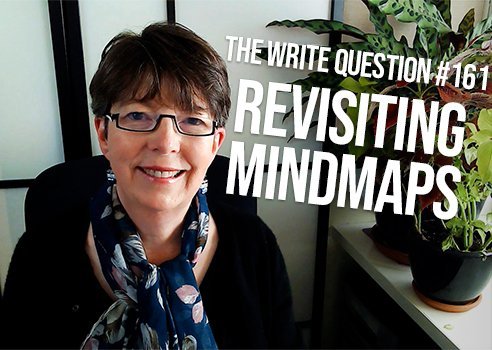Viewing time: 4 mins 40 secs
The Write Question is a weekly video podcast about writing that I started in 2017 and that ran, more or less weekly, until April 2022. This is a republication of issue #161, which considers whether it’s wise to revisit mindmaps. The post first ran on Oct. 30/20.
Transcript:
Is it wise to revisit mindmaps? That’s the topic I’m addressing today in The Write Question. I’m Daphne Gray-Grant, the Publication Coach, still in pandemic mode.
I have a question from Edson Bueno, a writer based in Brazil. Here’s what he’s asked by email….
“Do you keep revisiting your mindmaps? And, if so, is the purpose to refresh your memory or is it to change/add things? Also, have you ever had the experience of using a whiteboard for mindmapping? I’m a software engineer and have had many great experiences using whiteboards for coming up with solutions. I wonder if it’s because of the size of the whiteboard — they are so big that you feel immersed. Or perhaps it’s because you’re standing up and that seems to lead to more creativity.”
Thanks for your question, Edson. I’m a huge advocate of mindmapping and I’ve written a number of blog posts on the topic and created videos, too. For a link to ALL this material, please go to the show notes, below.
Let me emphasize I regard mindmapping as an inspirational rather than an organizational activity. For this reason, I never revisit mindmaps. I do them and then they inspire me or they don’t. If they don’t inspire, then I do another one.
Rather than revisiting mindmaps, I think it’s better to start new ones. Here’s how the sequence should go:
Step 1: THINK about what you want to write. This may take several hours, days or, very rarely, weeks.
Step 2: Take a piece of paper, turn it sideways and write a question about your topic in the centre of the page. A question is going to be way more useful than a topic.
Step 3: Mindmap on this question for 3 to 5 minutes. This means writing down anything that springs into your brain. Don’t make your notes detailed. Instead, use something like two to four words that will help you remember your point. I’m showing you an example of a mindmap on the screen. Excuse my hard-to-read printing.
Step 4: While you’re mindmapping, look for what I call the “aha!” experience. This means you are suddenly excited about the idea of writing and you can’t wait to get started. As soon as you have the “aha!” stop mindmapping and start writing.
Step 5: If you don’t have an “aha!” experience, then start a second mindmap, using a different question in the centre of the page.
Step 6: If you don’t have an aha experience after the second mindmap, then do a third one, using a different question again. And if the third doesn’t work, try a fourth. Keep mindmapping for as long as it takes.
If you worry that mindmapping is going to be too time-consuming, remember that an inspirational mindmap should take only three to five minutes to complete. This means you’ll be able to create as many as six to 10 mindmaps in 30 minutes.
I’ve known people who will sit and stare at a blank screen for 30 minutes. At least with mindmapping you’re doing something that’s fun, interesting and that will bring you closer to your material.
With respect to using a whiteboard, I think that’s a great idea even though I can’t do it myself because I don’t have a big enough wall in my own office. But if you do, go for it! Edson, I think your guesses about the benefits of whiteboard mindmapping are correct. Both the size of the area and the act of standing are likely very helpful to you.
The main thing is to keep mindmapping: It really is like a bit of pixie dust for writers.
Finally, let me wrap up with a quote from the late mindmapping popularizer Tony Buzan:
“Mind mapping is a technique based on memory and creativity and comprehension and understanding, so when someone uses the mind map, they are using their brain in the way their brain was designed to be used.”
Edson, mindmapping is a great way to inject more creativity in your life. I encourage you to continue using it in order to inspire your writing.
*
If you’d like to learn more about how to make writing a happier and more rewarding process, check out my latest book Your Happy First Draft. I don’t sell it in bookstores or via Amazon. The only place to buy it is on my website, link on the screen below and in the show notes.


